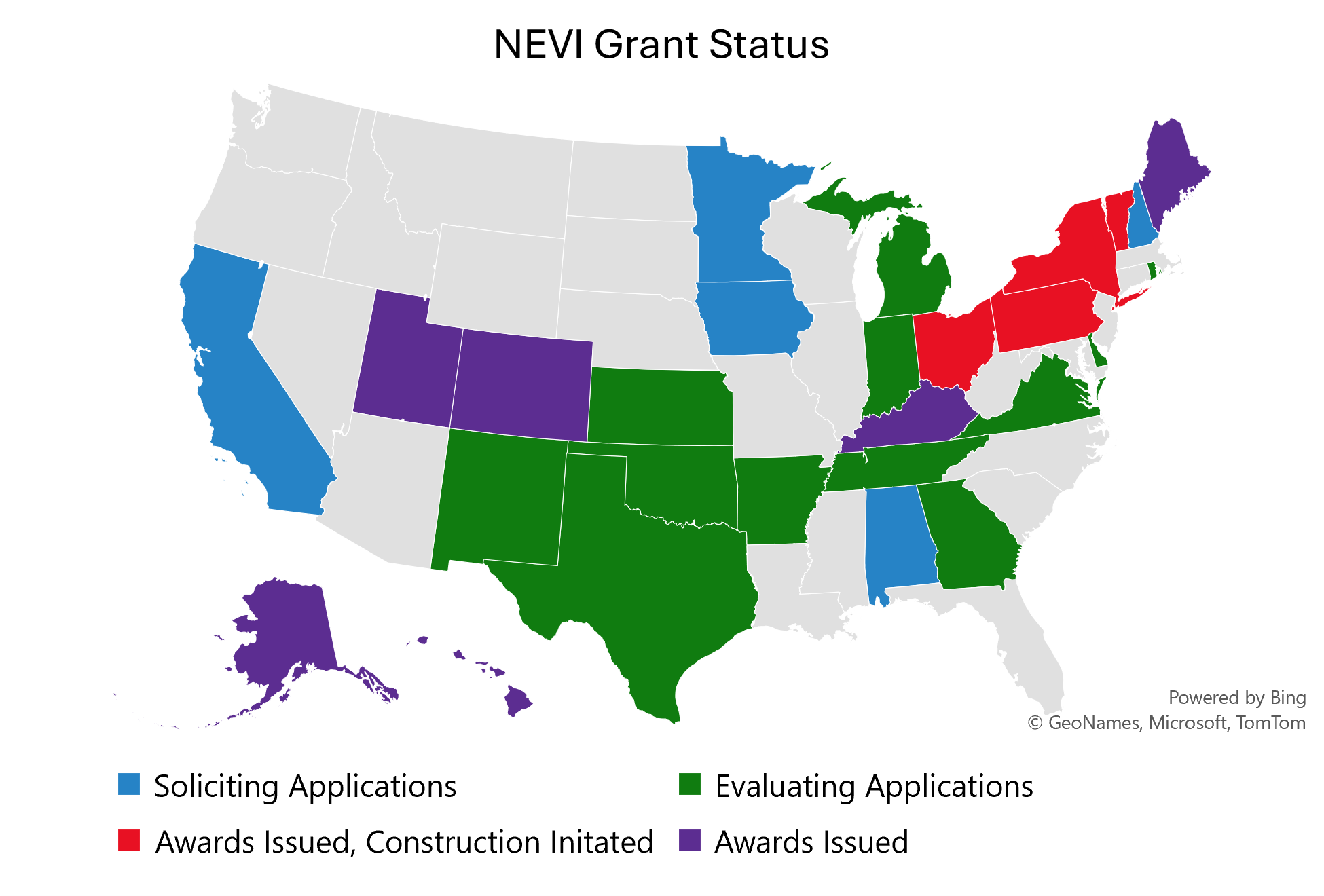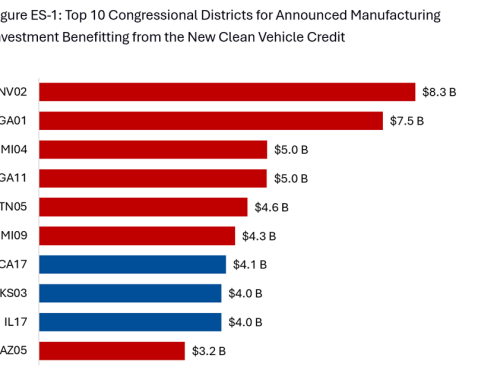
The map above shows the status of states’ NEVI grant solicitation process as of December 15th, 2023.
On December 8th, Ohio Governor Mike DeWine announced the opening of the nation’s first electric vehicle (EV) charging station funded through the National Electric Vehicle Infrastructure (NEVI) program. Located at a Pilot Travel Center west of Columbus and operated by EVgo, this station is capable of delivering up to 350 kilowatts (kW) of power to a single vehicle and can charge up to four vehicles at once with power-splitting (175 kW for each port).
A week later, New York followed suit and announced the opening of a NEVI-funded charger in Kingston. The New York Power Authority (NYPA), who is the recipient of the state’s first installment of NEVI funds, plans to open an additional dozen stations by the end of 2024 to close the remaining charging gaps along major state highways.
Several other states have already initiated the construction process for chargers funded through the program. Ohio’s neighbor to the east, Pennsylvania, recently broke ground in November on the state’s first NEVI-funded charger at a Pilot Travel Center on Route 315 in Pittston, and dozens of projects are slated to begin construction in the Keystone state over the next year. And in the Northeast, both Vermont and Maine have broken ground on their first-round NEVI sites, with stations expected to open sometime in the new year.
States make progress on contracting
As we recognize these “groundbreaking” milestones in five states, most states have been making considerable progress in deploying NEVI funds. At the time of this writing, 26 states have solicited proposals from potential applicants, like EV service providers (EVSPs) and site hosts, to construct, own, and operate charging stations. Of those states, nine are currently accepting proposals, and 12 states are evaluating applications. Four states have even opened their second-round NEVI solicitations: Colorado, Maine, Ohio, and Pennsylvania.
Within the next several months, most states will be issuing awards and begin the contracting process with grantees. New Mexico stated they will execute project contracts at the end of this month. Tennessee is slated to announce award recipients on January 5th, while Virginia is expected to announce its first-round awardees in February.
Ten states have issued NEVI funding
To date, ten states have issued NEVI awards to EVSPs and site hosts, issuing at least $130 million in NEVI dollars to support the construction of hundreds of sites. These first-mover states are Alaska, Colorado, Hawaii, Kentucky, Maine, Pennsylvania, Ohio, Vermont, New York, and Utah.
Most states have issued awards in line with a traditional request for proposals (RFP) process; however, some states have opted to issue initial funding through a direct contract, including Hawaii, Vermont, and New York. In Hawaii, Sustainability Partners will be the sole operator and Tritium will be the hardware provider for all sites in Hawaii via direct contract. The New York Department of Transportation and NYPA entered into a $20 million contractual agreement for the first installment of NEVI funds along major highway corridors and expects most of the projects to be completed by the end of 2024. And Vermont is using initial NEVI funding to upgrade an existing site in the state to meet NEVI’s minimum standards, which will soon be complete. In the meantime, the state’s full RFP is currently under development.
Of the awarded sites we have tracked, Tesla won the highest share across all states, followed by Pilot Travel Center and Francis Energy.
Could states accommodate medium- and heavy-duty vehicles with NEVI funds?
While these chargers are primarily intended for light-duty passenger electric vehicles, questions around how NEVI funds could be used to accommodate medium- and heavy-duty (MDHD) vehicles have surfaced. As such, we reviewed 23 publicly available RFPs to understand if and how states have considered MDHD charging infrastructure when evaluating bids. We found that nearly half of the RFPs we reviewed required applicants to describe if and how they will accommodate MDHD charging, or they explicitly gave prioritization in scoring to those who did.
In the same vein, we screened approximately 159 NEVI award sites for those that could accommodate MDHD vehicles. In conducting this work, we reviewed the list of first-round NEVI awards for seven states (Alaska, Colorado, Maine, Kentucky, Ohio, Pennsylvania, and Utah) and identified truck stops and large gas stations that could accommodate larger parking spaces and pull-through parking, such as Love’s, Pilot Travel Center and Flying J Travel Center, Travel Centers of America, Sheetz, WaWa, and other large truck plazas. We found that more than 60 percent of sites selected for NEVI stations could accommodate larger vehicles in the future (Classes 3-8). The chart below visualizes MDHD accommodations at the NEVI sites we analyzed by state.
NEVI is ready for lift off
2023 was a productive year for NEVI and the program looks to break out in 2024. Already, more than half of states have initiated the contracting process to get chargers in the ground, and nearly $130 million in funding has been awarded to hundreds of sites across the country. As we wrap up the year with the opening of the nation’s first NEVI-funded charger, construction of dozens of NEVI chargers is underway, and these chargers are expected to become operational in 2024.
Before the end of next year, we expect most states will have NEVI sites operational or under construction and that will be a big step towards achieving the program’s goal of building a backbone for a national charging network.


